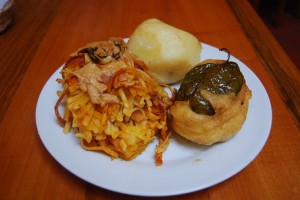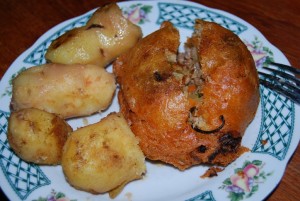Life, Death, and Stuffed Hot Peppers

Fat and sassy, rocotos rellenos (stuffed hot peppers) peer out from their wrappings on many street corners in Cuzco, such as where Maruri and Arequipa join a block from the main square, like so many babies properly bundled to go out in public.
Though people claim the rocoto relleno is from Arequipa, Cuzco’s are different enough and have deep enough roots to require separate discussion and distinction, and perhaps have a separate origin.
One of the main street foods, as well as something served as an appetizer or even a main course, rocotos rellenos are eaten regularly in Cuzco in a variety of places and circumstances.
They certainly inhabit street corners where like children they draw the attention of adults who can hardly resist their temptations. They appear as appetizers, the first courses of the standard Cuzco “menu” or set meal. Sometimes they are sides where anticuchos or some other dish gets top billing. But they also can be a main course in themselves, accompanied with their own potatoes–especially the tasty potato called peruanita.
While Arequipa has its style of rocoto relleno, the dish is also linked symbolically to other parts of the Peruvian map. It is found throughout Cuzco, but like the breads that come from outside the city limits a nearby city, Urcos, is also known for the quality of its rocoto rellenos.

When buses pull up to the main square in Urcos past its famous lake and its imposing colonial church, vendors cloak the sides of the bus offering their famous, large rocotos rellenos. To travel is to eat the foods that are typical of places and in Urcos that food is a rocoto relleno.
In both Cuzco and Urcos the rocoto relleno is covered in an egg batter and deep fried so it appears enclosed and golden, while the classic rocoto relleno from Arequipa is baked in an oven and appears nude. Somehow this is appropriate since Arequipa occupies a low, and warm, valley while both Urcos and Cuzco are highland cities, with Cuzco being substantially higher than Arequipa. In Cuzco you want to have a jacket and sweater handy, especially in the early mornings and at night.

The rocoto is an upland hot pepper. Though commercially farmed in the amazing, irrigated volcanic soils of Arequipa, the rocoto is the most cold-tolerant of hot peppers. I have seen rocoto plants easily ten or twelve feet tall and ornamented, like Christmas trees, with bright red fruits at more than twelve thousand feet in elevation on the Copacabana peninsula.
One day a light freeze hit. The next day the rocoto plant or (better said) tree’s leaves were blackened. But soon the plant started sending out new shoots. Most other peppers would have never survived the freeze.
The lowlands have many peppers. Arequipa is famous for supplying many kinds of peppers to highland markets. These include the long and red aji panca, and the bright yellow aji mirasol that find their place in much Peruvian cooking.
But the rocoto has pride in that the famous son of Cuzco, Garcilaso de la Vega, mentioned it as the common uchu of the land, the ordinary hot pepper that was somewhat elongated but rounded on the end; they did not come to a terminal point like most hot peppers. (Instead they are like the sweet peppers that are often used for stuffing in other lands, though this point was not mentioned by Garcilaso.) He contrasts them with the more specific, and pointed peppers that are not the common ones, the ones of the land.
One reading of this requires we argue that the rocoto was the ordinary hot pepper of the Inca capital, Cuzco, where–as Garcilaso notes–people hardly ate if their food were not accompanied by hot peppers.

Today, scholars distinguish the rocoto as a capsicum pubescens, distinctive for its hairy stems (hence pubescent) and its purple flowers, a color found on no other peppers. It also has very distinctive black or dark brown seeds while the seeds of all other species of peppers are white.
However, in the markets of Cuzco food is classified according to different characteristics, such as shape, rather than its formal species. As a result, peppers from other species can be called rocoto, though the pubescens is noticeably different in its seeds and taste, if not always its shape.
Nevertheless, the claim for an origin of the stuffed rocoto in Arequipa goes to a short story published by writer Carlos Herrera in 2005; he borrows from common folktales of the mining areas of Peru and Bolivia in which someone bargains with the devil. In this case the famous nineteenth chef Manuel Masias bnegotiated with the devil for the soul of his daughter who had died young. To win the bargain, he prepared an incredible banquet will all the best Arequipa had to offer, including rocotos rellenos, and won his daughter’s release from hell.
What parent would not be concerned with their child and would not be willing to use all at their disposal to win their child’s salvation. But, this story is not unique to Arequipa. Its fits a common genre of folktales found in much of the Andes. Furthermore, by locating the rocoto in the mythic struggle of life and death with the cosmos–such as the cthonic Andean figure of the devil who is often related to the saxra and powers of fertility in the earth–the story relates to other myths of origin of the rocoto.

In Ancash the rocoto is said to come from a high mountain lake. These lakes are places of origin, of birth, and as a result the rocoto gets associated with new birth and life. As a result it is especially associated with new life and children.
But, more importantly, its shape and the fact that it grows on very large bushes, akin to trees, reminds one of the very common story of the tree that had to be cut to bring food to human beings that is celebrated during carnival and in the feast of the godparents in Cuzco. Tomoeda, however, related this ritual to a different story of the fox who climbed to the heavens and ate at a heavenly banquet, but who on his return fell to earth. His stomach exploded and because of his gluttony and arrogance gave food to human beings.
The rocoto relleno is shaped like the potatoes often associated with the fox in this tale, and it grows on trees. But, to embed story within story, a not uncommon Andean characteristic, the rocoto is hollow and so can be filled with representatives of the other foods, such as chopped meat, diced potatoes, carrots, and onions, as well as sweet fruits like raisins. It becomes, whether mentioned or not, like the fox’s stomach that when opened bursts with all the different foods.
This mythic tradition is deep. It ties the Herrera’s story in a set of themes and stories that go beyond his specific invocation of a famous Arequipeñan chef who was so good he could even best the devil with his art, to the other trickster, the fox, who also bested the gods and then overcome by his self absorption was destroyed and gave people food. It locates the rocoto relleno in this problem of how people get food and the cosmically significant issues of birth and death.
The significance of this is underlined when one notices that though salt and hot peppers were things one sacrificed to fast and purify oneself in Inca times, one of the major myths of origin of the Incas–that of the Ayar siblings, has Manco Inca, the muythic founder accompanied by Ayar Hot Pepper (Uchu) and Ayar Salt (Cachi), neither of whom got to come to Cuzco but who played important roles as cosmic relatives and protectors of the incas.
The rocoto relleno is tied to this mythic heritage, especially when the very hot and juicy pepper is stuffed with what is Spanish is called a picadillo. But in Cusco, this is not enough, it like newborn children (who themselves are related to the ancestors) must be wrapped in an egg batter and deep fried.
Today people in Cuzco debate whether it is appropriate or not to continue wrapping a woven belt around small children or not, though that practice continues strongly in the countryside. However, they still cover the babies, especially newborns, in mounds of blankets to protect them from the cold, to be sure, but also to dress them and bring them into society.

The wild and fierce hot pepper, the rocoto, is also thus wrapped and presented well clothed to society, no longer in its natural state. Well-dressed it can now accompany potatoes or a meal and be lifted to the mouth. It has become food in a metaphor that makes things that are delicious in themselves good to eat because they become filled with significance.




